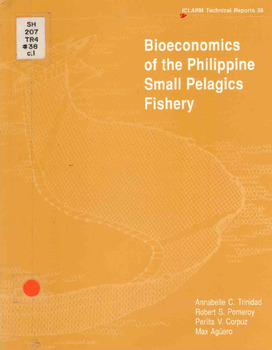Please use this identifier to cite or link to this item:
https://hdl.handle.net/20.500.12348/2929
Bioeconomics of the Philippine small pelagics fishery
| dc.creator | Trinidad, A.C. | |
| dc.creator | Pomeroy, R.S. | |
| dc.creator | Corpuz, P.V. | |
| dc.creator | Aguero, M.N. | |
| dc.date.accessioned | 2019-03-16T07:14:38Z | |
| dc.date.available | 2019-03-16T07:14:38Z | |
| dc.date.issued | 1993 | |
| dc.identifier | Pub TR4 38.pdf | |
| dc.identifier.citation | ICLARM Tech. Rep. (38): 74 p. | |
| dc.identifier.isbn | 971870938X | |
| dc.identifier.uri | https://hdl.handle.net/20.500.12348/2929 | |
| dc.description.abstract | Time series analysis of catch and effort data in the Philippines small pelagics fishery resulted in a level of biological and economic overexploitation. Open-access equilibrium has been reached at 410,000 hp representing a catch level of 465,000 tonnes. Present levels of effort would have to be reduced by 40% to attain maximum economic yield. An analysis of producer surplus showed that municipal aand commercial fishers were sustaining pure losses amounting to P9.4 billion indicating misallocation of labor and capital in an already overexploited fishery. Solutions to fisheries management problems are shown to emanate not just from the fishery, but more importantly, from the broader macroeconomic environment. | |
| dc.format | application/pdf | |
| dc.language | En | |
| dc.publisher | ICLARM | |
| dc.rights | CC BY 4.0 | |
| dc.title | Bioeconomics of the Philippine small pelagics fishery | |
| dc.type | Report | |
| dcterms.bibliographicCitation | Trinidad, A.C. et al. (1993). Bioeconomics of the Philippine small pelagics fishery. ICLARM Tech. Rep. (38): 74 p. | |
| cg.coverage.country | Philippines | |
| cg.identifier.worldfish | 110 | |
| cg.subject.worldfish | fisheries management | |
| cg.subject.worldfish | pelagic | |
| cg.identifier.status | Open access | |
| cg.description.theme | Resilient small-scale fisheries | |
| worldfish.location.area | Asia |
